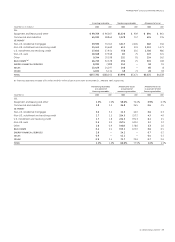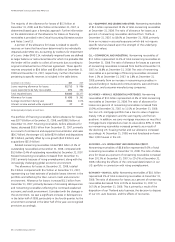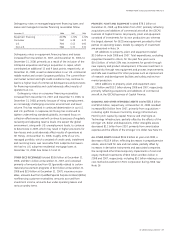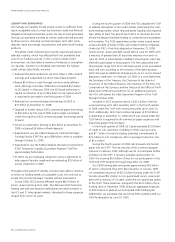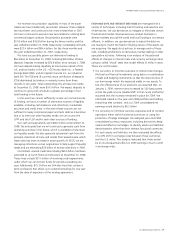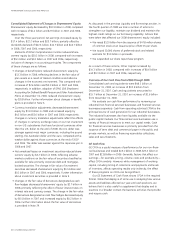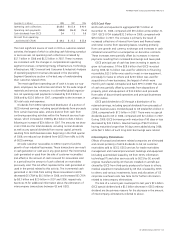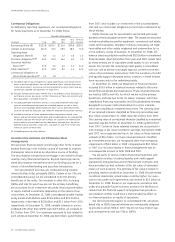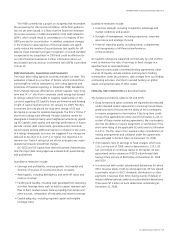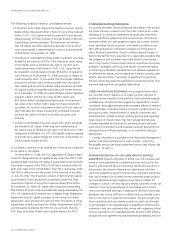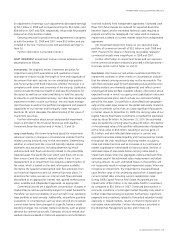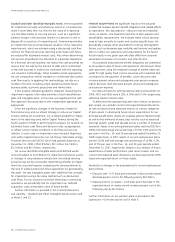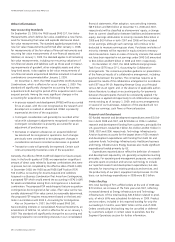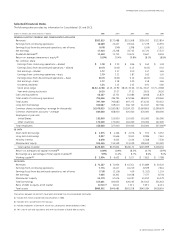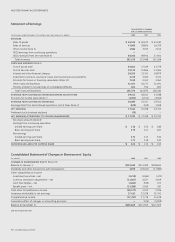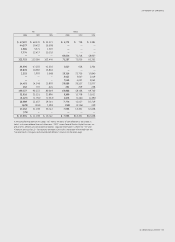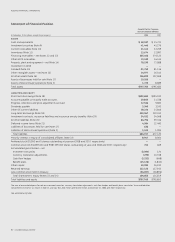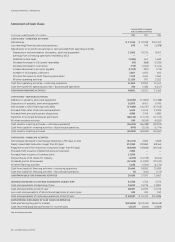GE 2008 Annual Report Download - page 47
Download and view the complete annual report
Please find page 47 of the 2008 GE annual report below. You can navigate through the pages in the report by either clicking on the pages listed below, or by using the keyword search tool below to find specific information within the annual report.management’s discussion and analsis
ge 2008 annual report 45
received routinely from independent appraisers. Estimated cash
flows from future leases are reduced for expected downtime
between leases and for estimated technical costs required to
prepare aircraft to be redeployed. Fair value used to measure
impairment is based on current market values from independent
appraisers.
We recognized impairment losses on our operating lease
portfolio of commercial aircraft of $0.1 billion in both 2008 and
2007. Provisions for losses on financing receivables related to
commercial aircraft were insignificant in 2008 and 2007.
Further information on impairment losses and our exposure
to the commercial aviation industry is provided in the Operations—
Overview section and in Notes 14 and 31.
Real Estate. We review our real estate investment portfolio for
impairment routinely or when events or circumstances indicate
that the related carrying amounts may not be recoverable. The
cash flow estimates used for both estimating value and the recov-
erability analysis are inherently judgmental, and reflect current
and projected lease profiles, available industry information about
expected trends in rental, occupancy and capitalization rates and
expected business plans, which include our estimated holding
period for the asset. Our portfolio is diversified, both geographi-
cally and by asset type. However, the global real estate market is
subject to periodic cycles that can cause significant fluctuations
in market values. At December 31, 2008, the carrying value of our
Capital Finance Real Estate investments exceeded the estimated
value by about $4 billion. At December 31, 2007, the estimated
value exceeded the carrying value by about $3 billion. This decline
in the estimated value of the portfolio reflected sales of properties
with a book value of $5.8 billion, resulting in pre-tax gains of
$1.9 billion, and also reflected deterioration in current and
expected real estate market liquidity and macroeconomic trends
throughout the year, resulting in declining market occupancy
rates and market rents as well as increases in our estimates of
market capitalization rates based on historical data. Declines in
estimated value of real estate below carrying value result in
impairment losses when the aggregate undiscounted cash flow
estimates used in the estimated value measurement are below
carrying amount. As such, estimated losses in the portfolio will
not necessarily result in recognized impairment losses. When we
recognize an impairment, the impairment is measured based
upon the fair value of the underlying asset which is based upon
current market data, including current capitalization rates.
During 2008, Capital Finance Real Estate recognized pre-tax
impairments of $0.3 billion in its real estate held for investment,
as compared to $0.2 billion in 2007. Continued deterioration in
economic conditions or prolonged market illiquidity may result in
further impairments being recognized. Furthermore, significant
judgment and uncertainty related to forecasted valuation trends,
especially in illiquid markets, results in inherent imprecision in
real estate value estimates. Further information is provided in
the Global Risk Management section and in Note 16.
an adjustment of earnings; such adjustments decreased earnings
by $0.2 billion in 2008 and increased earnings by $0.4 billion and
$0.8 billion in 2007 and 2006, respectively. We provide for probable
losses when they become evident.
Carrying amounts for product services agreements in progress
at both December 31, 2008 and 2007, were $5.5 billion, and are
included in the line, “Contract costs and estimated earnings” in
Note 16.
Further information is provided in Note 1.
ASSET IMPAIRMENT assessment involves various estimates and
assumptions as follows:
Investments. We regularly review investment securities for
impairment using both quantitative and qualitative criteria.
Quantitative criteria include the length of time and magnitude of
the amount that each security is in an unrealized loss position
and, for securities with fixed maturities, whether the issuer is in
compliance with terms and covenants of the security. Qualitative
criteria include the financial health of and specific prospects for
the issuer, as well as our intent and ability to hold the security
to maturity or until forecasted recovery. Our other-than-temporary
impairment reviews involve our finance, risk and asset manage-
ment functions as well as the portfolio management and research
capabilities of our internal and third-party asset managers.
See Note 28, which discusses the determination of fair value of
investment securities.
Further information about actual and potential impairment
losses is provided in the Financial Resources and Liquidity —
Investment Securities section and in Notes 1, 9 and 16.
Long-Lived Assets. We review long-lived assets for impairment
whenever events or changes in circumstances indicate that the
related carrying amounts may not be recoverable. Determining
whether an impairment has occurred typically requires various
estimates and assumptions, including determining which
undiscounted cash flows are directly related to the potentially
impaired asset, the useful life over which cash flows will occur,
their amount, and the asset’s residual value, if any. In turn,
measurement of an impairment loss requires a determination of
fair value, which is based on the best information available.
We derive the required undiscounted cash flow estimates from
our historical experience and our internal business plans. To
determine fair value, we use our internal cash flow estimates
discounted at an appropriate interest rate, quoted market prices
when available and independent appraisals, as appropriate.
Commercial aircraft are a significant concentration of assets in
Capital Finance, and are particularly subject to market fluctuations.
Therefore, we test recoverability of each aircraft in our operating
lease portfolio at least annually. Additionally, we perform quarterly
evaluations in circumstances such as when aircraft are re-leased,
current lease terms have changed or a specific lessee’s credit
standing changes. We consider market conditions, such as global
demand for commercial aircraft. Estimates of future rentals and
residual values are based on historical experience and information


